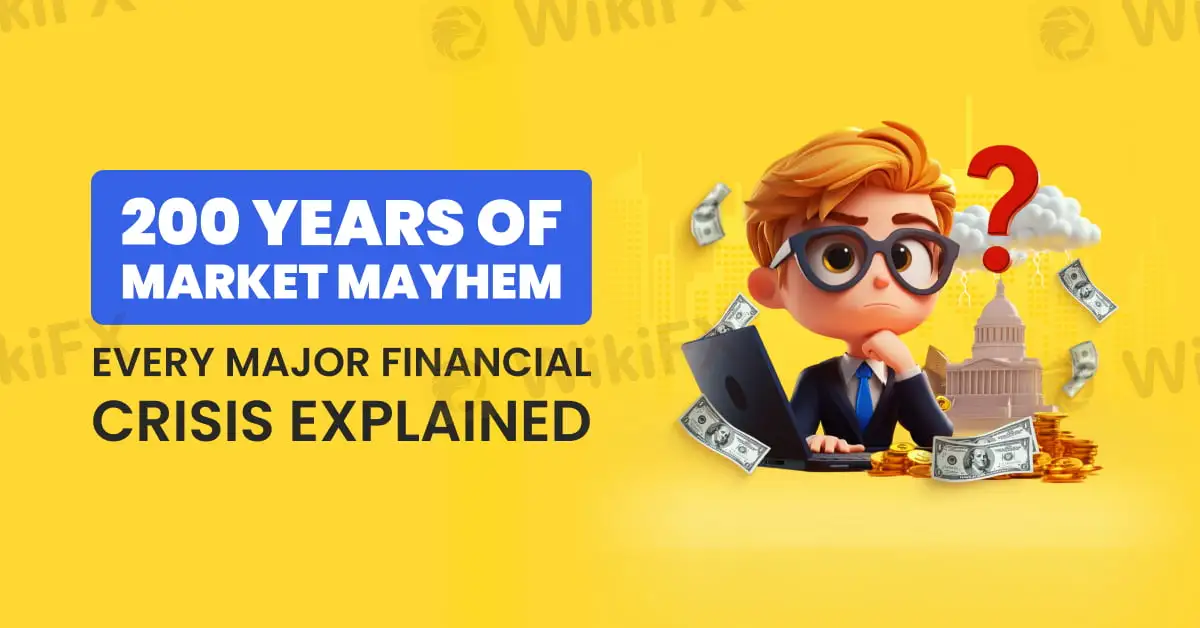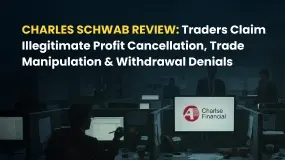简体中文
繁體中文
English
Pусский
日本語
ภาษาไทย
Tiếng Việt
Bahasa Indonesia
Español
हिन्दी
Filippiiniläinen
Français
Deutsch
Português
Türkçe
한국어
العربية
200 Years of Market Mayhem: Every Major Financial Crisis Explained
Abstract:Financial crises have shaped economies for centuries, often leaving a trail of devastation in their wake. While each crisis has its own unique causes, recurring themes, such as speculation, regulatory failures, and external shocks, continue to threaten global markets. This article explores the most significant financial collapses in history, revealing the patterns that link past crises to modern financial instability.

Financial crises have shaped economies for centuries, often leaving a trail of devastation in their wake. While each crisis has its own unique causes, recurring themes, such as speculation, regulatory failures, and external shocks, continue to threaten global markets. This article explores the most significant financial collapses in history, revealing the patterns that link past crises to modern financial instability.

The first recorded financial crisis in the United States occurred in 1792, triggered by speculative trading in government bonds. A wave of panic led to bank failures, forcing the newly established U.S. financial system to stabilise through the intervention of Alexander Hamilton. Decades later, the 1837 U.S. Banking Crisis saw widespread bank failures after a speculative land boom collapsed, deepening a long economic downturn.
By 1857, a combination of rail industry overexpansion and declining European demand for U.S. goods led to another financial crash, proving that global markets were becoming increasingly interconnected. This was followed by the 1873 Long Depression, a pan-European financial crisis sparked by bank failures in Austria and the collapse of the U.S. railroad industry.

As financial markets grew, crises became more complex. The 1893 U.S. Banking Crisis saw the collapse of over 500 banks due to a failing gold standard and declining investor confidence. Decades later, the infamous 1929 Great Depression began with the Wall Street Crash, leading to mass unemployment and a prolonged economic downturn that lasted a decade.
By the 1970s, external shocks played a larger role in financial instability. The 1973 Oil Crisis was triggered by an OPEC embargo, leading to soaring fuel prices and inflation. The 1979 Second Oil Crisis compounded these problems, causing a global economic slowdown.

As global markets became more intertwined, financial crises took on a new dimension. The 1982 Latin American Debt Crisis arose when major South American economies, burdened by unsustainable debt, defaulted on their loans. The shockwaves were felt worldwide, reinforcing the risks of excessive borrowing.
The 1987 Black Monday crash saw stock markets collapse globally, with the Dow Jones losing 22% of its value in a single day—an early warning of the risks associated with computerised trading. The 1992 European Exchange Rate Mechanism Crisis followed, as speculative attacks on the British pound forced the UK to withdraw from the ERM.
By 1994, Mexicos economy was in turmoil due to unsustainable debt and investor panic, leading to the Tequila Crisis, which necessitated an emergency bailout. Three years later, the 1997 Asian Financial Crisis saw massive currency devaluations across Thailand, Indonesia, and South Korea, exposing weaknesses in emerging market economies.

The 2000 Dot-Com Bubble Burst wiped out billions in speculative internet-based stocks, underscoring the dangers of overhyped technology investments. Just eight years later, the 2008 Global Financial Crisis, driven by subprime mortgage lending and excessive risk-taking, plunged the world into a deep recession. The fallout led to sweeping banking regulations and government bailouts.
In 2010, the European Sovereign Debt Crisis emerged as countries like Greece, Portugal, and Spain struggled with debt repayment, testing the resilience of the Eurozone. Most recently, the 2020 Covid-19 Global Financial Crisis caused markets to crash as the pandemic shut down economies worldwide, prompting unprecedented fiscal stimulus and monetary interventions.

Financial crises are inevitable, but history shows that regulatory oversight, responsible investment strategies, and early intervention can mitigate their impact. As markets evolve, understanding past collapses remains crucial in preventing the next economic disaster.

Disclaimer:
The views in this article only represent the author's personal views, and do not constitute investment advice on this platform. This platform does not guarantee the accuracy, completeness and timeliness of the information in the article, and will not be liable for any loss caused by the use of or reliance on the information in the article.
Read more

Charles Schwab Review: Traders Claim Illegitimate Profit Cancellation, Trade Manipulation & More
Have you been lured into the Charles Schwab app for trading on the back of outrageous profit claims by the broker? Did you fail to receive any of these? Does the broker deny withdrawals every time you request and cancel your forex trading account? Have you been victimized financially by its trade manipulation? Act before you are left with a NIL balance in your account. Many traders have questioned Charles Schwab customer service and many other operational executives for the aforementioned illegitimate trading activities. In this Charles Schwab review article, we have shared some of their comments. Read on!

AMP Futures Exposed: Traders Raise Alarms Over Illegitimate Account Blocks & Bad Customer Service
Has AMP Futures blocked your forex trading account? Does it fail to provide any explanation for this act? Do you face issues concerning deposits to your AMP Futures account? Is the customer service non-existent for any trading query you raise with it? You are not alone! Many traders have been facing these issues upon AMP Futures login. Some of them have commented on AMP Futures review platforms. In this article, we have shared some reviews that you can look at. Read on!

FXGlory Review: Vanishing Profits, Capital Scams & Withdrawal Charges Keep Annoying Traders
Does FXGlory remove all your forex trading account balances upon fund withdrawal requests? Or do you witness incorrect trading account balances after fund withdrawals? Does the Saint Lucia-based forex broker charge you for fund withdrawals? All these and many more scam-related complaints have been filed against the forex broker. In this FXGlory review article, we will discuss several complaints. Read on!

PINAKINE Broker Review: A Complete Look at Its Services and Risks
Finding a trustworthy broker from the huge and often confusing world of online trading options is one of the biggest challenges a trader faces. In this competitive market, PINAKINE Liquidity Limited has appeared, getting attention with promises of high leverage and zero-commission trading. However, a closer look shows important factors that every potential client must think about before investing. The most important thing to consider with PINAKINE is that it has no regulation. This fact completely changes how risky the broker is and has major effects on how safe your investments will be. This review gives a complete and fair examination based on information available to the public. We will break down its services, trading conditions, platform technology, and the possible risks involved, helping you make a fully informed decision.
WikiFX Broker
Latest News
Private payrolls rose 42,000 in October, more than expected and countering labor market fears, ADP says
Yields Rise, Rate-Cut Odds Slide As ISM Services Survey Signal Inflation Fears
Op-ed: The fuel for the AI boom driving the markets is advertising. It is also an existential risk.
Stonefort Broker Review 2025: Legit or Risky? A Complete Analysis
He Thought It Was a Crypto Investment; It Cost Him RM1.2 Million
CHINA BEST Broker Review: Regulation and Risks
Uniglobe Markets Review 2025: A Safe Broker or a High-Risk Scam?
Chicago Fed's Goolsbee says he's cautious about further rate cuts during shutdown
These Are Europe's Top Economies By Projected 2026 GDP
Quantower Review 2025: User Reviews and Complaints in India
Currency Calculator




